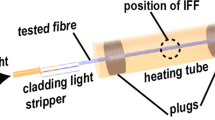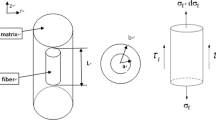Abstract
Through theoretical analysis and experiments, the viscoelastic mechanical model of optical fiber coupler in the process of fused biconical taper was established, and the numerical analysis in non-uniform temperature field was made. The results show that the rheological parameters, such as drawing speed and fused temperature, have a tremendous influence on stress distribution and performance of optical fiber coupler, especially the influence of fused temperature. The change of fused temperature by 5 °C can lead to the change of the maximum stress by 30% and stress difference by 20% in the same cross section. The change of temperature gradient by 3% can result in the change of stress difference by 90%. In the present condition of rheological technology, rheological defects such as crystallizations and microcracks are easy to generate in the optical fiber coupler.
Similar content being viewed by others
References
SONG Jin-sheng. Technological advance and developmental trend of passive devices in China [J]. Broadband Web in the World, 2002, 9(11): 16–18. (in Chinese)
Pal B P, Chaudhuri P R, Shenoy M R. Fabrication and modeling of fused biconical tapered fiber couplers[J]. Fiber and Integrated Optics, 2003, 22(2): 97–117.
SHUAI Ci-jun, DUAN Ji-an, ZHONG Jue. Technical sensitiveness in the rheological manufacture progress of fused taper coupler[J]. Optics and Precision Engineering, 2005, 13(1): 40–46. (in Chinese)
Sakai M, Shimizu S. Indentation rheometry for glassforming materials[J]. Journal of Non-crystalline Solids, 2001, 282(1): 236–247.
Diauov E M. The different condition influence in the process drawing fiber from prefabricate stick[J]. Glass Tech, 1998, 29(6): 123–129.
Hsu C M, Su C T, Liao D. A novel approach for optimizing the optical performance of the broadband tap coupler[J]. International Journal of Systems Science, 2003, 34(3): 215–226.
George W S. Model of structure relaxation in glass with variable coefficient[J]. Communications of American Ceramic Society, 1986, 89(7): 94–96.
SHUAI Ci-jun, DUAN Ji-an, MIAO Jian-yu. Thermal analysis of fused biconical taper in the process of optical fibre coupler pre-drawing [J]. Journal of Central South University of Technology: Science and Technology, 2004, 35(4): 618–621. (in Chinese)
Jerzy Z. Glasses and amorphous materials[M]. Translated by QIAN Fu- xi. Beijing: China Science Press, 2002. (in Chinese)
Doremus R H. Melt viscosities of silicate glasses[J]. Journal of American Ceramic Society, 2003, 202(3): 105–110.
Sakaguchi S, Todoroki S. Viscosity of silica core optical fiber [J]. Journal of Non-crystalline Solids, 1999, 244(2): 232–237.
Scherer G W. Theorites of relaxation[J]. Journal of Non-crystalline Solids, 1990, 123(2): 75–89.
Bonnet J P. On the thermally activated structural relaxation in glasses [J]. Journal of Non-crystalline Solids, 1991, 127(2): 227–231.
Pone E, Daxhelet X, Lacroix S. Refractive index profile of fused-tapered fiber couplers[J]. Optics Express, 2004, 12(13): 2909–2918.
Hsueh C H. Mathematical model of viscosity measurements for viscoelastic solids [J]. Journal of American Ceramic Society, 1996, 169(3): 48–49.
Cassagnau P, Melis F. Non-linear viscoelastic behaviour and modulus recovery in silica filled polymers[J]. Polymer, 2003, 44(21): 6607–6615.
Author information
Authors and Affiliations
Corresponding author
Additional information
Foundation item: Project (50235040) supported by the National Natural Science Foundation of China; project (NCET-040753) supported by the New Century Excellent Talent in University; project (20050533037) supported by the Doctoral Program of Higher Education
Rights and permissions
About this article
Cite this article
Shuai, Cj., Duan, Ja. & Zhong, J. Relationship between rheological manufacturing process and optical performance of optical fiber coupler. J Cent. South Univ. Technol. 13, 175–179 (2006). https://doi.org/10.1007/s11771-006-0152-z
Received:
Accepted:
Published:
Issue Date:
DOI: https://doi.org/10.1007/s11771-006-0152-z




